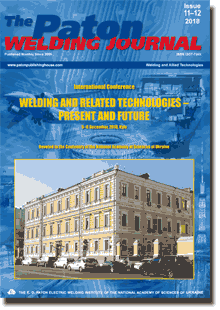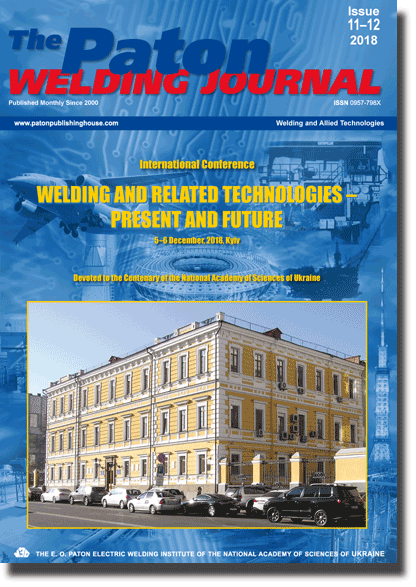| 2018 №12 (14) |
DOI of Article 10.15407/tpwj2018.12.15 |
2018 №12 (16) |

The Paton Welding Journal, 2018, #11-12, 134-139 pages
Journal The Paton Welding Journal
Publisher International Association «Welding»
ISSN 0957-798X (print)
Issue #11-12, 2018 (November)
Pages 134-139
Tendencies of development of special electrometallurgy of titanium in Ukraine
S.V. Akhonin
E.O. Paton Electric Welding Institute of the NAS of Ukraine 11 Kazimir Malevich Str., 03150, Kyiv, Ukraine. E-mail: office@paton.kiev.ua
The analysis was carried out on the main tendencies of development of special electrometallurgy of titanium in Ukraine. It is one of five countries, having complete cycle of titanium production from extraction of titanium-containing ores, their enrichment and production of spongy titanium to melting of titanium alloy ingots and production of virtually complete spectrum of titanium semi-products. Metallurgical processing of spongy titanium into ingots in Ukraine is based on technology of electron beam melting with cold hearth, which finds wide application in the world for melting of ingot-slabs. This technology provides guaranteed removal of refractory inclusions and the possibility to get the ingots of various cross-section per one remelting from charge materials of low price that ensures high technical-economical indices of melting process. Production of semi-products of titanium alloys from the ingots was organized at the Ukrainian enterprises. There are castings, forgings, rods, hot- and cold-rolled pipes, mechanical properties of which correspond to requirements of the standards. Today Ukraine has got a competitive for the world’s markets production of high-quality ingots and ingot-slabs from titanium and alloys on its basis, which has large perspectives for further development. 8 Ref., 1 Table, 10 Figures.
Keywords: titanium, electron beam melting, ingot, quality, refractory inclusions
Received: 08.08.18
Published: 23.11.18
References
1. Koshelap, A.V., Rajchenko, A.I. (1999) On possibility of structure refining of cast titanium and its alloys due to their modification with titanium nitride particles. Protsessy Litya, 3, 44-52 [ in Russian].
2. Mitchel, A. (1987) The production of high-quality materials by special process. J. Vac. Technol., 4 (Jul./Aug.), 2672-2677. https://doi.org/10.1116/1.574716
3. Bewley, B.P., Gigliotti, M.F.X. (1977) Dissolution rate measurements of TiN in Ti-6242. Acta Mat., 45(1), 357-370. https://doi.org/10.1016/S1359-6454(96)00098-5
4. Bellot, J.P., Mitchell, A. (1994) Hard-alfa particle behavior in a titanium alloy liquid pool. Light Metals, 2, 1187-1193.
5. Akhonin, S.V., Kruglenko, M.P., Kostenko, V.I. (2011) Mathematical modeling of process of dissolution of oxygen-containing refractory inclusions in titanium melt. Sovrem. Elektrometall., 1, 17-21 [in Russian].
6. Paton, B.E., Trigub, N.P., Akhonin, S.V., Zhuk, G.V. (2006) Electron beam melting of titanium. Kiev, Naukova Dumka [in Russian].
7. Akhonin, S.V., Trigub, N.P., Zamkov, V.N., Semiatin, S.L. (2003) Mathematical modeling of aluminium evaporation during electron-beam cold-hearth melting of Ti-6Al-4V ingots. Metall. and Mater. Transact. B, 34B (August), 447-454. https://doi.org/10.1007/s11663-003-0071-4
8. Akhonin, S.V., Berezos, V.A., Pikulin, A.N., et al. (2014) Electron beam melting of surface of titanium alloy ingots. Sovrem. Elektrometall., 2, 21-25 [in Russian].
Suggested Citation
S.V. Akhonin (2018) Tendencies of development of special electrometallurgy of titanium in Ukraine. The Paton Welding J., 12, 134-139.The cost of subscription/purchase order journals or individual articles
| Journal/Currency | Annual Set | 1 issue printed |
1 issue |
one article |
| TPWJ/USD | 384 $ | 32 $ | 26 $ | 13 $ |
| TPWJ/EUR | 348 € | 29 € | 24 € | 12 € |
| TPWJ/UAH | 7200 UAH | 600 UAH | 600 UAH | 280 UAH |
| AS/UAH | 1800 UAH | 300 UAH | 300 UAH | 150 UAH |
| AS/USD | 192 $ | 32 $ | 26 $ | 13 $ |
| AS/EUR | 180 € | 30 € | 25 € | 12 € |
| SEM/UAH | 1200 UAH | 300 UAH | 300 UAH | 150 UAH |
| SEM/USD | 128 $ | 32 $ | 26 $ | 13 $ |
| SEM/EUR | 120 € | 30 € | 25 € | 12 € |
| TDNK/UAH | 1200 UAH | 300 UAH | 300 UAH | 150 UAH |
| TDNK/USD | 128 $ | 32 $ | 26 $ | 13 $ |
| TDNK/EUR | 120 € | 30 € | 25 € | 15 € |
AS = «Automatic Welding» - 6 issues per year;
TPWJ = «PATON WELDING JOURNAL» - 12 issues per year;
SEM = «Electrometallurgy Today» - 4 issues per year;
TDNK = «Technical Diagnostics and Non-Destructive Testing» - 4 issues per year.


